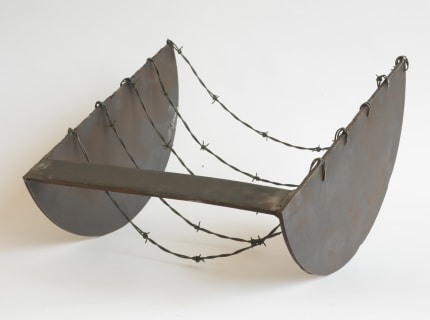Melvin Edwards
Melvin Edwards is best known for his wall sculptures “Lynch Fragments,” a series made of welded metal scraps that he began in the early 1960s in response to racial violence in the United States. Recently, however, another side of Edwards has emerged: an artist engaged with installation — and a skillful painter. “Lines for the Poet” at Alexander Gray unveils some of these overlooked aspects of his career.
Sculpture in the 20th century wasn’t a bastion of color, but Edwards shows himself to be a buoyant colorist in a series of watercolors made around 1974. Moreover, for Black artists, there was the dilemma of whether to engage with abstraction, the dominant avant-garde mode, or figurative and representational art, historically championed for pursuing social justice. The watercolors deftly engage both: There are exuberant drips and splatters but also the shadowy imprint of hooks and chains, suggesting imprisonment and repression.
“Lines for the Poet,” a post-Minimalist installation made with barbed wire attached to a steel beam, was conceived in 1970 and completed this year. (Similar works by Edwards are on long-term view at Dia Beacon.) The sculpture is reminiscent of the spatial installations made with yarn by Fred Sandback, but it also paves the way for artists like Mona Hatoum, who harnessed the stark Minimalist vocabulary and used it for social critique. Modernist abstraction, after all, was supposed to signal freedom and utopia; it took artists like Edwards to remind us that, for many, liberation was still out of reach. MARTHA SCHWENDENER
...
Read full article at nytimes.com.

